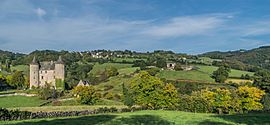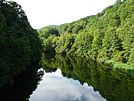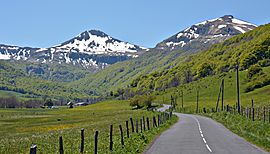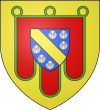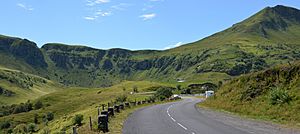Cantal facts for kids
Quick facts for kids
Cantal
|
|||
|---|---|---|---|
|
From top down, left to right: Château de Réghaud in Sénezergues, Rhue River, Truyère River, Cheylade
|
|||
|
|||

Location of Cantal in France
|
|||
| Country | France | ||
| Region | Auvergne-Rhône-Alpes | ||
| Prefecture | Aurillac | ||
| Subprefectures | Mauriac Saint-Flour |
||
| Area | |||
| • Total | 5,726 km2 (2,211 sq mi) | ||
| Population
(Jan. 2020)
|
|||
| • Total | 144,379 | ||
| • Rank | 98th | ||
| • Density | 25.2146/km2 (65.306/sq mi) | ||
| Time zone | UTC+1 (CET) | ||
| • Summer (DST) | UTC+2 (CEST) | ||
| Department number | 15 | ||
| Arrondissements | 3 | ||
| Cantons | 15 | ||
| Communes | 246 | ||
| French Land Register data, which exclude estuaries and lakes, ponds and glaciers larger than 1 km2 | |||
Cantal (Occitan: Cantal or Cantau) is a special area in France called a department. It's located in the Auvergne-Rhône-Alpes region. The main city and capital of Cantal is Aurillac. Other important towns include Saint-Flour and Mauriac. People from Cantal are called Cantalians.
Cantal is in the Massif Central mountain area. It shares borders with several other departments like Puy-de-Dôme and Aveyron. Cantal is one of the least populated and most isolated departments in France. Aurillac is the capital city farthest from a major highway. In 2019, about 144,692 people lived there. This makes it the 98th most populated department in France.
Contents
What's in a Name?
The department of Cantal gets its name from the Plomb du Cantal. This is a tall, rugged mountain peak in the mounts of Cantal mountain range. This mountain range crosses through the whole area.
Exploring Cantal's Geography
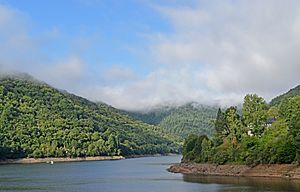
Cantal is located in the middle of France's central plateau. The Cantal mountains are actually a group of old, worn-down volcanoes that are no longer active. The highest point is the Plomb du Cantal, which is about 1,858 meters (6,096 feet) high. Nearby are Puy Mary (1,787 meters or 5,863 feet) and Puy Chavaroche (1,744 meters or 5,722 feet). To the north, you'll find the Cézallier and Dore ranges. There is also the dry Artense Plateau. To the east is the fertile Planèze Plateau.
The main rivers in Cantal include the Alagnon, Celle, Truyère, Cère, and Rhue. The lowest point in the department is in the Lot valley, about 250 meters (820 feet) above sea level. The Truyère valley runs along the south of the Planèze. It separates it from the Monts d'Aubrac, where you can find the hot springs of Chaudesaigues. The western part of Cantal has many grassy plateaus and river valleys.
Cantal's Climate
The weather in Cantal can change a lot depending on where you are. Winds and mountains divide the department into four different climate zones:
- The west side gets a lot of rain from ocean winds.
- The Cantal and Cézallier mountains block some rain, but it still rains and snows often there.
- The Planèze of Saint-Flour and the Massiac area get less rain. This is because of winds from the north and south.
- The plateaus of Margeride and Aubrac have cold winters and nice summers.
Generally, the weather is mild and dry in the flat areas between Murat and Saint-Flour, and around Aurillac. However, summer storms and winters can be long and harsh in the northern and central parts. The west, closer to the Atlantic, gets plenty of rain. There's a lot of snow, which can stay on the mountaintops for up to six months. Winter temperatures can drop below -15°C (5°F). In summer, temperatures often reach 25°C (77°F). The southern part of the department, near Aveyron and Lot, is the warmest area. Aurillac gets about 2080 hours of sunshine each year. Fog is rare and clears up quickly. Winds are usually not very strong. However, the lightning storms in Cantal are some of the most amazing in France!
French weather forecasts sometimes say Aurillac is the coldest city in France in the mornings. This is because Aurillac is at a high altitude, about 640 meters (2,100 feet) above sea level. It's much higher than most of the other 30 cities on their weather maps.
Main Towns in Cantal
The biggest town in Cantal is Aurillac, which is the capital. As of 2019, five towns in Cantal have more than 3,000 people:
| Commune | Population (2019) |
|---|---|
| Aurillac | 25,593 |
| Saint-Flour | 6,458 |
| Arpajon-sur-Cère | 6,279 |
| Ytrac | 4,335 |
| Mauriac | 3,498 |
A Look at Cantal's History
The area that is now Cantal was historically part of a region called Haute-Auvergne. Cantal was one of the first 83 departments created in France. This happened during the French Revolution on March 4, 1790.
Religious History
After 1790, some changes were made to the church in France. The Diocese of Saint-Flour in Cantal was one of many church areas that were changed or removed. This was done to match the new department borders. Later, after Napoleon's time, the bishopric of Saint-Flour was brought back. It kept the same borders as the Cantal department.
Cantal's Economy
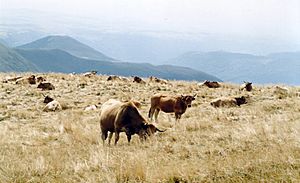
The climate in Cantal is often too cool and wet for growing grains. Because of this, much of the land is used for pasture. Farmers raise Aubrac and Salers cattle, as well as sheep. This helps support a dairy industry that makes butter and famous cheeses. These cheeses include Cantal, Salers, and Bleu d'Auvergne. Cantal has the most "appellation-controlled" cheeses in France. This means these cheeses must be made in a specific way in this region. However, real Roquefort cheese is now only made in the Aveyron department.
Cantal also has natural resources like coal, copper, and iron. But for a long time, it was hard to get these resources out because the department was isolated. Before the First World War, Cantal mainly exported livestock, cheese, and butter. It imported things like wine and grain. By then, it had train connections, which helped with trade.
In the past, many Cantalians traveled around France for work. Today, Cantal doesn't have a lot of big industries. This makes it a great place for tourism. A large area has been set aside as the Auvergne Volcanos Regional Park.
People of Cantal
The Occitan language was traditionally spoken in Cantal. In 2019, the official population was 144,692 people. The population was highest in 1836, with over 262,000 people. Since the First World War, the population has been below 200,000. Like many rural areas in France, Cantal's population decreased a lot during the 20th century. This happened because farm wages couldn't keep up with the pay in industrial areas. Cantal is part of a region in France known for having a low population density.
Population changes in Cantal since 1791:
| Historical population | ||||||||||||||||||||||||||||||||||||||||||||||||||||||||||||||||||||||||||||||||||||||||
|---|---|---|---|---|---|---|---|---|---|---|---|---|---|---|---|---|---|---|---|---|---|---|---|---|---|---|---|---|---|---|---|---|---|---|---|---|---|---|---|---|---|---|---|---|---|---|---|---|---|---|---|---|---|---|---|---|---|---|---|---|---|---|---|---|---|---|---|---|---|---|---|---|---|---|---|---|---|---|---|---|---|---|---|---|---|---|---|---|
|
|
|||||||||||||||||||||||||||||||||||||||||||||||||||||||||||||||||||||||||||||||||||||||
| source: | ||||||||||||||||||||||||||||||||||||||||||||||||||||||||||||||||||||||||||||||||||||||||
Tourism and Fun in Cantal
Amazing Architecture
Cantal has many interesting old buildings. These include Romanesque churches from the 11th century, like the churches of Cheylade and Massiac. The main Catholic cathedral in the area is the 15th-century St Pierre de St-Flour, built in the Gothic style.
You can also visit several castles:
- Castle of Val in Lanobre (about 36,500 visitors each year)
- Castle of Anjony in Tournemire (about 20,000 visitors each year)
- Castle of Pesteils in Polminhac (about 11,700 visitors each year)
- Castle de la Vigne in Ally (about 6,000 visitors each year)
- Castle of Clavières in Ayrens
- Castle of Carbonat in Arpajon-sur-Cère
- Chateau de Conros, near Aurillac
Exciting Festivals
Cantal hosts several fun festivals:
- International Festival of Street Theatre in Aurillac.
- World Music Festival in Murat.
- 36 hours: Many small shows with dances.
- International Boogie Woogie Festival in Laroquebrou.
Art and Culture
The traditional folk dance in Cantal is called La Bourrée. In the countryside, people would dance it in folk costumes, often with accordion music. This dance style was also used in fancy court music centuries ago.
There are many interesting museums in Cantal:
- Museum of Art and Archaeology in Aurillac (about 34,100 visitors each year)
- The House of Fauna in Murat (about 23,500 visitors each year)
- Museum of Géothermia in Chaudes-Aigues (about 20,600 visitors each year)
- Museum of the Volcanos in Aurillac (about 20,100 visitors each year)
- Museum of the Ray in Marcenat (about 11,500 visitors each year)
- Museum of the "Haute Auvergne" in Saint-Flour (about 11,100 visitors each year)
- The House of the Chestnut in Mourjou (about 5,200 visitors each year)
- Museum of Georges Pompidou in Montboudif (about 3,500 visitors each year)
- Museum of the Accordion in Siran
- Museum of Agriculture in Auvernia, Coltines
Delicious Cuisine
Traditional Cantalian food used ingredients like rye, buckwheat, chestnuts, ham, cheese, and vegetables. The simple recipes were made to feed farmers and herders in the hills. Some famous dishes include:
- Aligot: Creamy mashed potatoes mixed with fresh cheese (tomme), butter, cream, and a little garlic.
- Truffade: Sliced potatoes cooked with fresh cheese (tomme) and a little garlic.
- Pounti: A cake made with black wheat flour dough, herbs, lard, prunes, and Swiss chard.
- The special cheese Cantal, which can be young, old, or "entre-deux" (in between).
Fun Outdoor Activities
In the 19th century, Cantal's hills and valleys were full of game animals, and the streams had lots of fish. The countryside also had many aromatic and medicinal plants.
Today, popular places to visit include Puy Mary and the Plomb du Cantal mountains. The village of Salers and the Truyère gorges are also popular. In the gorges, you can see the Garabit viaduct (a famous bridge) and the castle of Alleuze. The Parc Naturel des Volcans d’Auvergne is a park with several inactive volcanoes. Cantal also has many castles to explore.
You can easily reach Puy Mary by car or by hiking. You can also hike to the nearby Puy de Peyre-Arse (1,806 meters or 5,925 feet). Le Lioran or Super-Lioran are good places to start your hike. Le Lioran can be reached by train or bus, and Super-Lioran is only one kilometer away. From Super-Lioran, you can also hike to Plomb du Cantal. There's even a cable car to take you to Plomb du Cantal from Super-Lioran. The Super-Lioran tourist office has maps for different hiking routes. You can also find adventure courses, dirt bikes, and summer sleds there.
Cantal offers many activities. You can explore the "Massif Cantalien" by walking, horseback riding, or mountain biking on special trails. Water sports are also popular because of the many lakes. You can also try mountaineering, canoeing, and fishing. The landscape is also great for free flight, like base jumping, especially around Puy Mary.
Because of its mountains, Cantal gets a lot of snow, which is perfect for winter sports. The Le Lioran ski resort is the biggest in the Massif Central. It offers downhill skiing (with areas for snowboarding) and ice-skating. You can also go snowshoeing. Cantal has hundreds of kilometers of trails for cross-country skiing.
-
Truyère river and Château d'Alleuze
Cantal's Politics
Cantal has historically been a strong supporter of the political right in France. It was the home base for the late Georges Pompidou, who later became the French president. Only the area around Aurillac has some support for left-wing politics. This is because Aurillac has historically been more against the influence of the church.
Paul Doumer, who was the French president from May 1931 to May 1932, was born in Aurillac in this department.
See also
 In Spanish: Cantal para niños
In Spanish: Cantal para niños


